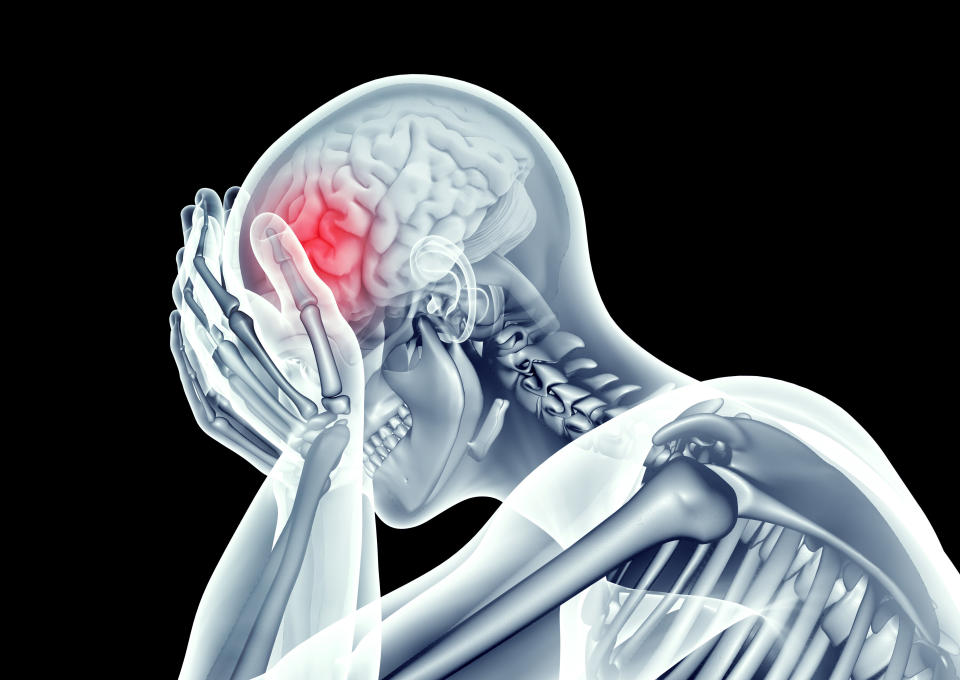What the Health?! Man suffers stroke after trying to get rid of knot in his neck
Can leftover spaghetti really kill you? Can you actually cough up a blood clot in the shape of your lung? In Yahoo Lifestyle Canada‘s newest series, What The Health?!, we ask doctors to weigh in on odd health news stories and set the record straight. Be sure to check back every Friday for the latest.

Have you ever had a knot or in your neck and “popped” it to get rid of the pain? Well, you might want to avoid doing that in the future.
A 28-year-old father of two from Guthrie, Okla. was cracking his neck because of some discomfort that had lasted for weeks—and suffered a major stroke as a result.
“I went to stretch it,” Josh Hader told the Washington Post. “As I was using my hand to apply a little bit more pressure than I probably should have, I heard a pop.”
ALSO SEE: Oilers' owner's life-threatening illness is a scary reminder of antibiotic resistance
In that instant, he felt everything on the left side of his body go numb. Within an hour, he was admitted to hospital, unable to walk.
Hader learned that in cracking his neck, he had torn his vertebral artery, causing a clot, that blocked blood flow to the brain. The medical name for the condition is cervical artery dissection.

“He could have had a life-ending stroke,” Dr. Vance McCollom, a radiologist at Mercy Hospital, Oklahoma City,” told KOCO News. “If you have a stroke in that area, you can end up with a patient who’s locked in. They completely understand what's going on, but they can't communicate. They can't move anything. They can't speak. They can't breathe.
“If you want to pop your neck, just kind of pop it side to side. Don’t twist it,” McCollum warned. “Whenever you twist it there's a risk of tearing that vessel. I suspect he just turned it [his head] real sharp and up, sharp and up and back. That’s what really pinched it.”
ALSO SEE: Woman fears excessive dancing caused her uterus to 'fall out'
Hader, who had to use a walker for the first few days after his stroke, is doing physical therapy as he recovers. He began experiencing double vision, and had to wear an eye patch because his right eye was weakened due to an injured nerve.
Although rare, there have been cases of a stroke occurring after stretching the neck.
A 23-year-old paramedic in London, England, suffered a stroke earlier this year after she cracked her neck and ruptured a major artery.

The woman had been watching a movie in bed when she went to stretch her neck and didn’t think much of the cracking sound at the time. In an interview with the Daily Mail she said that about 15 minutes later when she got up, she fell to the floor because she couldn’t move her left leg.
According to the American Heart Association, having your neck adjusted by a chiropractor or osteopath may also be associated with an increased risk of stroke. The techniques involved in manipulating the neck vary, but can include rotation of the neck and forceful thrusts.
ALSO SEE: Spider bite leaves child with gaping hole in leg
Dr. Thalia Field, a stroke neurologist at the Vancouver Stroke Program, tells Yahoo Canada that, although she can’t comment on such cases specifically, an arterial dissection can occur when layers of the vessels that carry blood from the heart to the brain separate, which can narrow or block the vessel or lead to a blood clot within it.
When blood flow to the brain is disrupted, this can cause a stroke.
Dissection is a rare cause of stroke overall, affecting about 1 out of every 10,000 people, but is one of the most common causes of stroke in younger adults, Field said.

According to the American Heart Association, this type of injury accounts for eight to 25 percent of stroke cases in patients under age 45.
“Sometimes there is a clear trigger where the blood vessel could have been twisted or otherwise stretched suddenly or violently—such as a car accident, an intense move at the gym, coughing intensely or cracking one’s neck—or was in an odd position for a long time, such as a hairdresser or falling asleep sitting up, but sometimes there is no clear mechanical trigger,” Field explained.
ALSO SEE: Mom with rare double uterus gives birth twice in one month — but how?
“We see more dissections in the winter during cold and flu season, and in some cases the vessels may be more fragile for a period of time after a viral infection,” she added. “Sometimes, people may have an underlying issue with the structure of their blood vessels that makes them more susceptible.”
Field, who’s also an assistant professor of neurology at the University of British Columbia, emphasized that it’s impossible to avoid moving the neck in certain ways, and that dissections are rare events that may be caused by motions that millions of people do every day without any issue.

However, “many stroke neurologists would recommend avoiding situations where one is voluntarily submitting to intense neck manipulation,” she said.
Strokes can happen at any age, and while dissections most commonly present with headache and neck pain, that’s not always the case.
ALSO SEE: Did this 25-year-old contract a rare autoimmune disorder from a cat?
“Any sudden spells where one has difficultly moving one side—the face, arm, or leg—difficulty speaking or sudden vision loss or double vision, or severe vertigo, in particular with numbness or tingling, double vision, or slurred speech, should call 911 and seek medical attention immediately, even if the symptoms go away,” Field said. “Stroke symptoms and warning spells that receive appropriate medical attention immediately have the lowest likelihood of permanent problems.”
The easiest way to remember the signs of stroke is the FAST acronym:
F—Face: Is it drooping?
A—Arms: Can you raise both?
S—Speech: Is it slurred or jumbled?
T—Time: It’s time to call 911 right away.
Let us know what you think by commenting below and tweeting @YahooStyleCA!Follow us on Twitter andInstagram.
Check out Yahoo Canada’s podcast, Make It Reign — our hot takes on all things royals in a non-stuffy way — onApple Podcasts and Google Podcasts.



